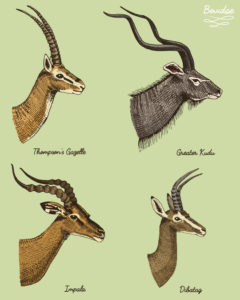Table of Contents
What is the difference between a Gazelle & an Antelope?
One of the most common animals that you will encounter on your Tanzanian Safari Tour is the Antelope or Gazelle.
There are about 91 Antelope and Gazelle species in the world- roughly 72 of which, make the continent of Africa their home. On a Northern Tanzania Safari ( Serengeti, Ngorongoro & Lake Manyara), you are likely to encounter both Antelopes and Gazelles in abundance; it may become clear, however, that they are hard to tell apart. So, what is the difference between the two? To confuse you more, the basic answer is: Not all Antelopes are Gazelles, but all Gazelles are Antelopes.
Gazelles are part of the Antelope genus, and the Antelope is part of the Bovidae family (a family of cloven-hoofed, ruminant mammals). All-together, they make up quite a variety of different safari animals which include the famous Waterbucks, Wildebeest & Impalas, among many, many more. They both have a 4 chamber stomach and appear to be the same animal- so what is the difference?
Size
Gazelles are often smaller than other Antelopes. This is exemplified no better than between the Thompson Gazelle (30kgs) and the huge Eland (950kg). For those that don’t do maths, that is 920kgs, which is equal to a sports car. Huge.
Horns
Unlike Antelopes, most types & both genders of Gazelles have horns. Impalas, for instance, only the males have horns; this is why an impala is an Antelope, yet not a Gazelle.
Stotting
Stotting is when a predator startles an animal and they move slowly before bolting vertically into the air. Upon landing their leap, they hit their full stride to get away the danger. Gazelles are known to display this behaviour, while Antelopes do not.
While these are the main differences between the Gazelle and Antelope, each species of both genus has other unique defining features which are spectacular in their own right. They make the diversity of the wildlife on Safari much more fascinating- identifying each Gazelle & Antelope makes for a fantastic day game viewing.


